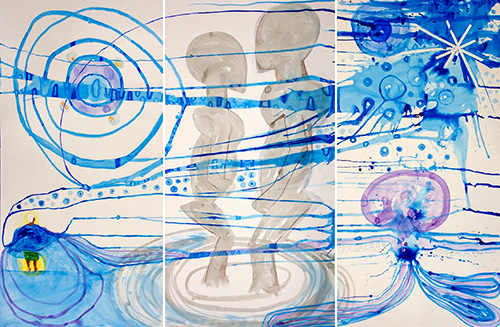
The Sea and Cuban Artist María Magdalena Campos-Pons. -“There is no place to go except to the sea,” said María Magdalena Campos-Pons. The Sea has always been an inspiration for artists. But it has a special relationship to artists from islands like Cuban artist María Magdalena Campos-Pons. The latest exhibit at Haggerty Museum of Art explores her connection to the maritime subject. Sea and Self is the name of the show. It will be on view until December 19, 2021.
Campos-Pons perceives the sea as a mother, angry and in danger. She also sees the sea as a place of memory, a site of loss. It holds the history of a foreign land once her home. She disguises the sentiments in a cool blue and white while exclaiming grief in stark lines. The feeling is a sense of drowning. Letting the old sink into the new through art.
Some of her paintings take on a Rothschild element as she uses inks to splash marks. One often has too look deeper to find what propels from their subconscious. In this way, the Cuban artist is quite the Surrealist. But we don’t fix to labels as the Latin Americans turned to a magical realism that enabled them to dig deep into the treasures of their ancestry. Instead of the subconscious they looked to history.
For María Magdalena Campos-Pons the history is trifold: Nigerian, Hispanic, and Chinese. Her Nigerian ancestors were brought down in slave ships in the 19th century. They passed down traditions, rituals and beliefs. These included religious beliefs like Catholicism and Santeria, which are a huge element of her art.
Along with the series of paintings that focus on the sea, her photographs and installations are also part of the exhibit.
I come from an island. Continental experiences and borders are so meaningful, and to be surrounded by water is quite a unique and magnificently humbling thing. There is no place to go except to the sea.
– María Magdalena Campos-Pons
The renowned artist was born in 1959 in Matanzas, Cuba in the town of La Vega. She grew up on a sugar plantation. She is a descendant of Nigerian slaves, Chinese indentured servants, and Spanish immigrants. For more information, please visit the following links.
Link to the original article
